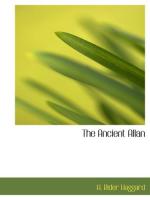one of his high ministers or generals who wore the
King’s cartouche upon his ring in token of
his office, of course I cannot say.
“When George had read the cartouche he handed me the ring which I slipped upon the first finger of my left hand, where I still wear it. Then leaving the grave open for further examination, we went on with the work, for we were greatly excited. At length, this was towards evening, we had cleared enough of the sanctuary, which was small, to uncover the shrine that, if not a monolith, was made of four pieces of granite so wonderfully put together that one could not see the joints. On the curved architrave as I think it is called, was carved the symbol of a winged disc, and beneath in hieroglyphics as fresh as though they had only been cut yesterday, an inscription to the effect that Peroa, Royal Son of the Sun, gave this shrine as an ‘excellent eternal work,’ together with the statues of the Holy Mother and the Holy Child to the ’emanations of the great Goddess Isis and the god Horus,’ Amada, Royal Lady, being votaress or high-priestess.
“We only read the hieroglyphics very hurriedly, being anxious to see what was within the shrine that, the cedar door having rotted away, was filled with fine, drifted sand. Basketful by basketful we got it out and then, my friend, there appeared the most beautiful life-sized statue of Isis carved in alabaster that ever I have seen. She was seated on a throne-like chair and wore the vulture cap on which traces of colour remained. Her arms were held forward as though to support a child, which perhaps she was suckling as one of the breasts was bare. But if so, the child had gone. The execution of the statue was exquisite and its tender and mystic face extraordinarily beautiful, so life-like also that I think it must have been copied from a living model. Oh! my friend, when I looked upon it, which we did by the light of the candles, for the sun was sinking and shadows gathered in that excavated hole, I felt—never mind what I felt—perhaps you can guess who know my history.
“While we stared and stared, I longing to go upon my knees, I knew not why, suddenly I felt a faint trembling of the ground. At the same moment, the head overseer of the works, a man called Achmet, rushed up to us, shouting out—’Back! Back! The wall has burst. The sand runs!’
“He seized me by the arm and dragged me away beside of and behind the grave, George turning to follow. Next instant I saw a kind of wave of sand, on the crest of which appeared the stones of the wall, curl over and break. It struck the shrine, overturned and shattered it, which makes me think it was made of four pieces, and shattered also the alabaster statue within, for I saw its head strike George upon the back and throw him forward. He reeled and fell into the open grave which in another moment was filled and covered with the debris




